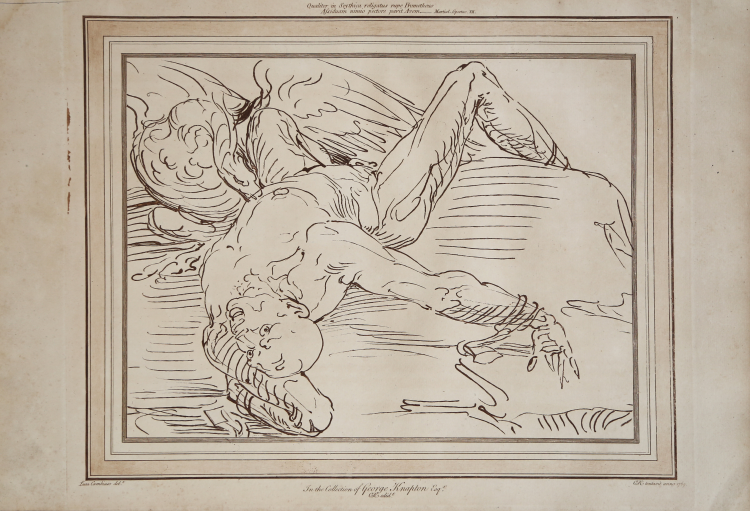



| Reference: | S49866 |
| Author | Charles ROGERS |
| Year: | 1769 |
| Measures: | 440 x 360 mm |


| Reference: | S49866 |
| Author | Charles ROGERS |
| Year: | 1769 |
| Measures: | 440 x 360 mm |
Prometheus manacled to the rock, in pain while the eagle feeds on his liver; after a drawing by Luca Cambiaso; in rectangular frame in imitation of a wash mount.
Etching and mezzotint, 1769, lettered below the image with production details.
From Tome I of Charles Rogers “A Collection of Prints in Imitation of Drawings to which are annexed lives with explanatory and critical notes by Charles Rogers Esq. F.R.S. S.A.L. / Quantanus nobis denegatur diu viver relinquamus aliquid quo nos vixisse testemur. Plin. Lib. III. Epist. 7 / Stampato da J. Nicholls, successore di Mr Bowyer e venduto da John Boydell, incisore, n. 93, Cheapside. Benjamin White, presso Horace's Head, Fleet-Street. Peter Molini, in Oxendon-Street, Hay-Market M.DCC.LXXVIII”.
The plates were engraved after drawings in major British collections, including Charles Rogers' own, and published in two volumes in London.
A very good impression on contemporary laid paper, with margins, a light foxing, otherwise in good condition.
|
Charles Rogers was born on August 2, 1711 to William and Isabella of Soho, London and went on to become an avid art collector. In 1731, he began working for William Townson at the Customs Office. Townson is the man the Cottonian Collection really began with. He collected books and prints and Rogers acquired his taste for the fine arts from him. When Townson died in 1740, he left his estate to Rogers. It included three houses, one of which was filled with art.
Prints were Rogers’ particular fascination. He started collecting in the 1730s and during his lifetime he built one of the largest and finest print collections in England.
Rogers had a discerning eye. He frequently changed prints for better impressions and used his network of dealers and agents to collect across Europe. He was also an author. In 1778, the year after he sat for this portrait, he published ‘A Collection of Prints in Imitation of Drawings to which are annexed Lives of their authors’.
Made up of two volumes it contained 112 copies of original old master drawings – not just from his own collection, but also from the Royal Collection and other private collections in England. He commissioned the leading engravers of the day to create versions that were as close as possible to the original drawings in size, colour and style.
Rogers commissioned Reynolds to create this portrait in 1777. An engraving by William Ryland (1733-1783) was made the following year. Rogers had some reservations about it and later wrote to art historian Horace Walpole (1717-1797) that he thought it made him look too young. Walpole replied to reassure him that "posterity will not know at what age the Likeness was taken"!
|
|
Charles Rogers was born on August 2, 1711 to William and Isabella of Soho, London and went on to become an avid art collector. In 1731, he began working for William Townson at the Customs Office. Townson is the man the Cottonian Collection really began with. He collected books and prints and Rogers acquired his taste for the fine arts from him. When Townson died in 1740, he left his estate to Rogers. It included three houses, one of which was filled with art.
Prints were Rogers’ particular fascination. He started collecting in the 1730s and during his lifetime he built one of the largest and finest print collections in England.
Rogers had a discerning eye. He frequently changed prints for better impressions and used his network of dealers and agents to collect across Europe. He was also an author. In 1778, the year after he sat for this portrait, he published ‘A Collection of Prints in Imitation of Drawings to which are annexed Lives of their authors’.
Made up of two volumes it contained 112 copies of original old master drawings – not just from his own collection, but also from the Royal Collection and other private collections in England. He commissioned the leading engravers of the day to create versions that were as close as possible to the original drawings in size, colour and style.
Rogers commissioned Reynolds to create this portrait in 1777. An engraving by William Ryland (1733-1783) was made the following year. Rogers had some reservations about it and later wrote to art historian Horace Walpole (1717-1797) that he thought it made him look too young. Walpole replied to reassure him that "posterity will not know at what age the Likeness was taken"!
|